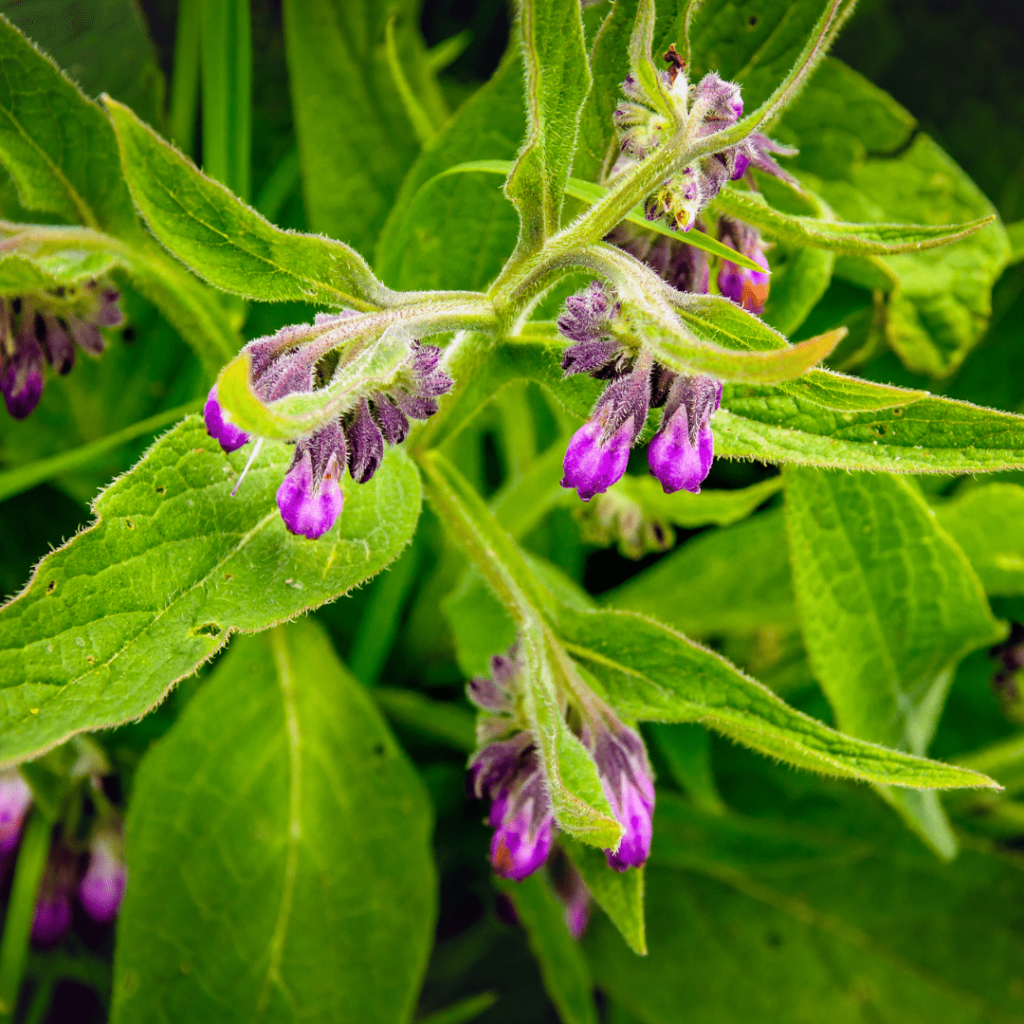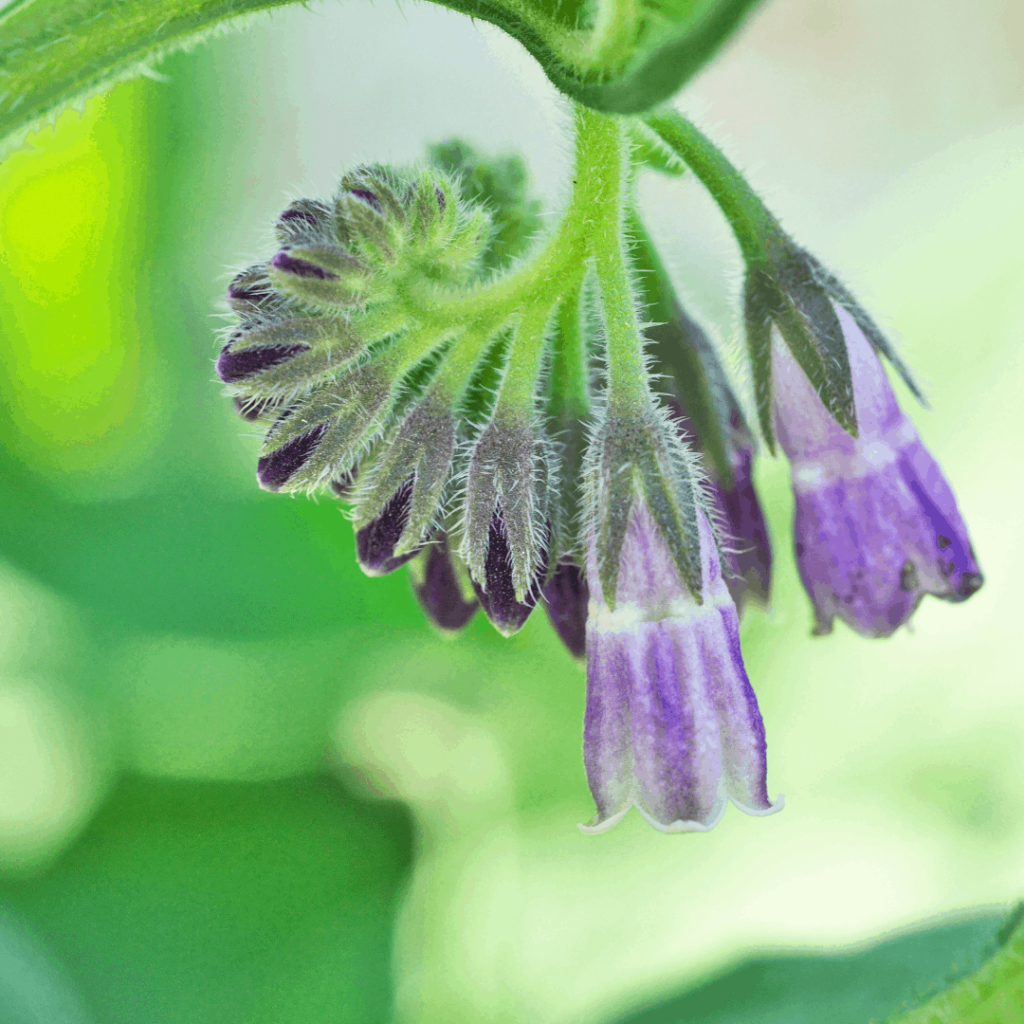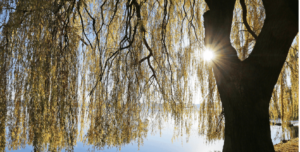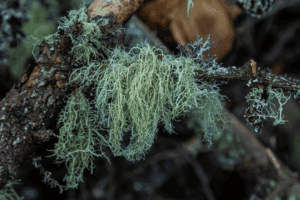Comfrey is an important plant in traditional Western herbalism, as well as in modern herbalism, but there’s a stigma around it too. People seem to be a bit scared of comfrey because of research showing that some of its constituents are potentially dangerous. But this is an herb that has been used in Western herbalism both topically and, yes—believe it or not—internally as well for a really long time. Few people talk about the possible internal usage of Comfrey. So this week, let’s look closer at this plant, including some of its uses and characteristics, so you can know more about it and be able to use it with greater confidence and competence.
Comfrey, or Symphytum officinale, is a remedy that has been around for a long time and is a popular herbal medicine. There is some controversy and differences of opinion around Comfrey. Most herbalists say that Comfrey is strictly for external use, even though old herbals will give all sorts of internal usage for it. In modern herbalism Comfrey is strictly applied topically because it contains a compound called pyrrolizidine alkaloids. Pyrrolizidine alkaloids have been shown to harm the liver, and therefore it is not recommended for not internal consumption. This warning is also now being applied to Boneset, Petasites, and Coltsfoot.
This is one of those times that science is butting heads with tradition a little bit. Here’s a plant that’s been used for a long time and has been used internally. It wasn’t killing anyone. Science discovered it has pyrrolizidine alkaloids. They probably administered that compound in isolation to some rats and it gave them liver cancer. And then scientists say that Comfrey isn’t safe in humans for internal consumption. But there’s a huge leap of logic there that is difficult for me to accept.
Nonetheless, topically speaking Comfrey essentially builds and generates tissue. That is the essence of what this plant does. It is one of the most powerful embodiments of the earth element, as well as the archetype of Saturn, because it builds structure. Comfrey also has a lot of the water element. With earth and water, it’s very powerful—it builds structure, it builds tissue. This is why topically it’s one of our top vulnerary plants, or wound-healing agents. Use it only on superficial wounds, though. Don’t use Comfrey for puncture wounds especially. Because it generates tissue so well, it will generate the top layer of tissue first, leaving the damaged tissue underneath, and then it’s not able to effectively drain or breathe and you can create abscesses or infections. So you always use Comfrey just on superficial scrapes, lacerations, and things like that. But it works very well.
Comfrey is vulnerary and also demulcent. So it’s good for dry conditions and skin conditions. It’s unique because it’s astringent and wound healing but also demulcent, so that’s a unique property that you don’t see in a whole lot of plants. Plantain has that a little bit, but Comfrey is a lot stronger.
Internally speaking, Comfrey has a strong effect on the gastric mucosa. This is a great plant because it’s wound healing. So think of that in the gut. Think of that in the stomach. Traditionally the demulcent can help cool down reflux, it has a wound-healing property, and it’s an excellent ulcer remedy, both in the gastric ulcer or ulcers in the stomach or in the intestines. It’s a great leaky gut plant—astringing and tonifying the gut mucosa. It will help any dryness in the gut. The demulcent property and the wound-healing property combined makes it a powerful agent for healing gastric tissue. That’s one of the main ways I like it.
Comfrey is also great for healing bones and connective tissues. Topically, you can use it on broken bones, sprains, strains in the tendons, ligaments, cartilage, all that stuff. It’s great for the connective tissue—again, building structure. It’s a connective tissue tonic and it combines well with things like mineral-rich plants: Nettles, Horsetail, and other connective tissue remedies, especially Solomon’s seal. It could be applicable for organ prolapse, used both topically and internally.
These are all basically relaxed tissue states, dry tissue states, hot inflamed tissue states. Comfrey is also ever so slightly cooling, but not so much that it’s going to make you cold. It’s going to soothe heat and irritation. It’s just a great remedy.
Generally speaking, if you’re going to administer Comfrey internally, I think it is best used in infusion form. From a pyrrolizidine alkaloids standpoint and from what I’ve been taught, the leaves tend to be lower in those alkaloids than the roots. Both parts of the plant are used. From my experience, the roots are more demulcent than the leaves. The leaves are a little more astringent than the roots. If you want to drink it or take it internally, I would recommend using the leaves, because a tincture is going to quite likely draw out more of those alkaloids, because alkaloids tend to like mid-range alcohol-water solutions.







